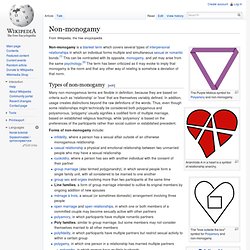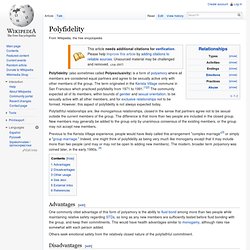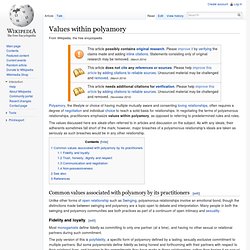

Alt.polyamory Frequently Asked Questions (FAQ) Poly for Beginners. Who among us hasn't been thrown completely off-kilter by a mad attraction to someone who (damn!)

Isn't our partner? If you're like most people, you (a) spend a season obsessing to your friends or a shrink in an awkward attempt to diffuse your inconvenient passion or (b) get swept up in a clandestine affair that has about as much hope for the happy-ever-after as Bill Clinton's Oval Office gropings with a certain beret-wearing intern. But what if you could trade all the sleepless should-I-stay-or-should-I-go nights for the possibility of bringing the new object of your affection home to be approved by your significant other? Welcome to the world of polyamory. An outgrowth of both the group marriage and communal living movements of the '60s and '70s, the still-young polyamory movement (and it is a movement, with literature that rails against “the serial monogamous monopoly”) espouses the value of committed, loving, relationships with more than one partner.
Where are all the Successful Poly Relationships? This is a question that comes up time and time again on poly internet sites.

It is often raised when people break up painfully (sometimes even publicly) prompting some in polyfi relationships to question their stability and those considering polyfidelity as a relationship option to wonder whether it is actually workable in practice. It seems to me that there are three main reasons why we don't see very many successful polyfi relationships. First, it is not that the successful relationships are not out there, but that they are not much publicised. There are quite a lot of people on the internet in successful polyfi relationships: some are very open about it, and others are much less obvious; you would have to read their posts pretty closely to discover it.
Polyamorous Relationships in New York City. What Is A Poly Relationship? A poly relationship takes a variety of forms and is interpreted differently, depending on context, history and cultural considerations.

Nonetheless, a poly relationship is contrasted with a monogamous relationship. Rather than an individual maintaining one partner at a time, she has multiple partners, who likewise have some sort of relationship with each other, according to "Opening Up: A Guide to Creating and Sustaining Open Relationships" by Tristan Taormino. Non-monogamy. The Purple Mobius symbol for Polyamory and non-monogamy.

Anarchists-A in a heart is a symbol of relationship anarchy. The "love outside the box" symbol for Polyamory and non-monogamy. Non-monogamy is a blanket term which covers several types of interpersonal relationships in which an individual forms multiple and simultaneous sexual or romantic bonds.[1] This can be contrasted with its opposite, monogamy, and yet may arise from the same psychology.[2] The term has been criticized as it may evoke to imply that monogamy is the norm and that any other way of relating is somehow a deviation of that norm. Terminology within polyamory. Terminology within polyamory looks at the evolution and meaning of the word "polyamory" itself, as well as alternate definitions and concepts which closely relate to it.

Overview[edit] 'Polyamory'[edit] History of the term[edit] The word polyamory does not actually appear in "A Bouquet of Lovers", referenced above. The article uses "polyamorous", but its original version introduced the term in hyphenated form, "poly-amorous".[2] The article consistently uses "polygamy" as the counterpart to "monogamy". Alt.polyamory participants collaborated on a FAQ (frequently asked questions) post that was updated periodically, and included the group's definition of "polyamory". Polyamory means "loving more than one". In 1999, Morning Glory Zell-Ravenheart was asked by the editor of the Oxford English Dictionary to provide a definition of the term (which the dictionary had not previously recognised). Polyfidelity. Polyfidelity (also sometimes called Polyexclusivity) is a form of polyamory where all members are considered equal partners and agree to be sexually active only with other members of the group.

The term originated in the Kerista Village commune in San Francisco which practiced polyfidelity from 1971 to 1991.[1][2] The community expected all of its members, within bounds of gender and sexual orientation, to be sexually active with all other members, and for exclusive relationships not to be formed. However, this aspect of polyfidelity is not always expected today. Polyfaithful relationships are, like monogamous relationships, closed in the sense that partners agree not to be sexual outside the current members of the group.
The difference is that more than two people are included in the closed group. New members may generally be added to the group only by unanimous consensus of the existing members, or the group may not accept new members. Advantages[edit] Values within polyamory. Polyamory, the lifestyle or choice of having multiple mutually aware and consenting loving relationships, often requires a degree of negotiation and individual choice to reach a solid basis for relationships.

In negotiating the terms of polyamorous relationships, practitioners emphasize values within polyamory, as opposed to referring to predetermined rules and roles. The values discussed here are ideals often referred to in articles and discussion on the subject. As with any ideals, their adherents sometimes fall short of the mark; however, major breaches of a polyamorous relationship's ideals are taken as seriously as such breaches would be in any other relationship. Common values associated with polyamory by its practitioners[edit] Fidelity and loyalty[edit] Most monogamists define fidelity as committing to only one partner (at a time), and having no other sexual or relational partners during such commitment.
Trust, honesty, dignity and respect[edit]